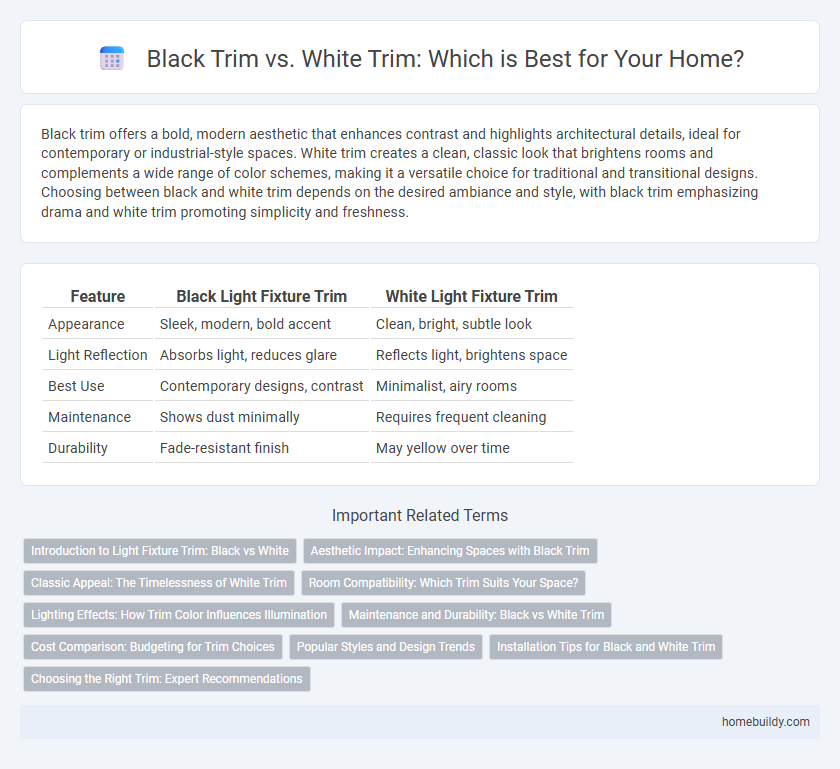Black trim offers a bold, modern aesthetic that enhances contrast and highlights architectural details, ideal for contemporary or industrial-style spaces. White trim creates a clean, classic look that brightens rooms and complements a wide range of color schemes, making it a versatile choice for traditional and transitional designs. Choosing between black and white trim depends on the desired ambiance and style, with black trim emphasizing drama and white trim promoting simplicity and freshness.
Table of Comparison
| Feature | Black Light Fixture Trim | White Light Fixture Trim |
|---|---|---|
| Appearance | Sleek, modern, bold accent | Clean, bright, subtle look |
| Light Reflection | Absorbs light, reduces glare | Reflects light, brightens space |
| Best Use | Contemporary designs, contrast | Minimalist, airy rooms |
| Maintenance | Shows dust minimally | Requires frequent cleaning |
| Durability | Fade-resistant finish | May yellow over time |
Introduction to Light Fixture Trim: Black vs White
Light fixture trim significantly impacts both the aesthetic and functionality of a room, with black and white trims serving distinct design purposes. Black trims offer a bold, modern look that enhances contrast and highlights the light source, making them ideal for contemporary and industrial interiors. White trims blend seamlessly with ceilings and walls, providing a clean, minimalistic finish that maximizes light reflection and creates a subtle visual effect.
Aesthetic Impact: Enhancing Spaces with Black Trim
Black light fixture trim creates a sleek, modern aesthetic that adds depth and contrast to any space, making it ideal for contemporary or industrial interiors. Its bold presence highlights architectural details and complements darker color palettes, enhancing the overall visual interest. Compared to white trim, black trim provides a striking focal point that elevates the sophistication and design coherence of rooms.
Classic Appeal: The Timelessness of White Trim
White trim on light fixtures offers a classic appeal that complements a wide range of interior styles, from traditional to modern. Its timeless elegance enhances natural light reflection, making spaces feel brighter and more open. Unlike black trim, white maintains versatility and a clean aesthetic that never goes out of fashion.
Room Compatibility: Which Trim Suits Your Space?
Black light fixture trim creates a bold contrast and works best in modern or industrial-style rooms with darker walls, adding a dramatic and sophisticated element. White trim blends seamlessly with neutral or light-colored ceilings and walls, providing a clean, minimalist look suitable for traditional, coastal, or Scandinavian interiors. Choosing between black and white trim depends on the room's color palette and desired visual impact, ensuring the trim complements rather than overpowers the space.
Lighting Effects: How Trim Color Influences Illumination
Black trim absorbs more light, reducing glare and creating a focused, cozy ambiance ideal for accent lighting or dramatic effects. White trim reflects light, enhancing brightness and diffusing illumination evenly, which is perfect for general lighting and making spaces appear larger. Choosing between black and white trim significantly influences the overall mood and visual perception of a room's lighting.
Maintenance and Durability: Black vs White Trim
Black trim on light fixtures tends to show dust, fingerprints, and scratches less visibly, requiring less frequent cleaning compared to white trim, which can stain or discolor over time and show dirt more prominently. Durable materials paired with black trim often maintain their appearance longer in high-traffic or industrial environments due to better concealment of wear and tear. White trim, while offering a crisp and clean look initially, demands more regular maintenance to preserve its brightness and is more prone to yellowing or fading under prolonged exposure to light and moisture.
Cost Comparison: Budgeting for Trim Choices
Black light fixture trim typically costs 10-15% more than standard white trim due to its specialized coating and finish processes. White trim remains a budget-friendly option, often found at lower prices in bulk purchases and wide availability. When budgeting, consider that black trim may add upfront expenses but can enhance aesthetic appeal and potentially increase property value, balancing the cost difference.
Popular Styles and Design Trends
Black trim has gained popularity for light fixtures in modern and industrial design trends, offering a sleek, bold contrast that enhances minimalist and contemporary spaces. White trim remains a classic choice favored in transitional and traditional interiors for its versatility and ability to blend seamlessly with ceilings, creating a clean and unobtrusive look. Current design trends emphasize matte and satin finishes in both black and white trims, with black often used to make a statement while white complements bright, airy environments.
Installation Tips for Black and White Trim
Black trim requires precise alignment to avoid visible gaps that contrast sharply against dark finishes, so using a level and measuring tools ensures a seamless fit. White trim is more forgiving with minor imperfections, but proper primer and paint application are essential to prevent discoloration and maintain a crisp appearance. Both trims benefit from secure fasteners and caulking to achieve a professional, polished installation in recessed or surface-mounted light fixtures.
Choosing the Right Trim: Expert Recommendations
Black trim offers a sleek, modern look that enhances contrast and hides dirt better than white trim, making it ideal for contemporary or industrial-style spaces. White trim provides a clean, classic appearance that blends seamlessly with ceilings and walls, promoting a bright, open feel suited for traditional or minimalist designs. Experts recommend selecting trim color based on room style, lighting conditions, and maintenance preferences to achieve optimal aesthetic and functional results.
black trim vs white trim Infographic

 homebuildy.com
homebuildy.com